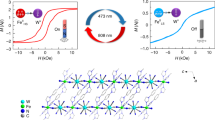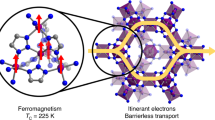Abstract
Bistable compounds that exist in two interchangeable phases under identical conditions can act as switches under external stimuli. Among such switchable materials, coordination complexes have energy levels (or phases) that are determined by the electronic states of their constituent metal ions and ligands. They can exhibit multiple bistabilities and hold promise in the search for multifaceted materials that display different properties in different phases, accessible through the application of contrasting external stimuli. Molecular systems that exhibit both thermo- and photoinduced magnetic bistabilities are excellent candidates for such systems. Here we describe a cyanide-bridged [CoFe] one-dimensional chiral coordination polymer that displays both magnetic and electric bistabilities in the same temperature range. Both the electric and magnetic switching probably arise from the same electron-transfer coupled spin-transition phenomenon, which enables the reversible conversion between an insulating diamagnetic phase and either a semiconducting paramagnetic (thermoinduced) or a type of ferromagnetic single-chain magnet (photoinduced) state.
This is a preview of subscription content, access via your institution
Access options
Subscribe to this journal
Receive 12 print issues and online access
$259.00 per year
only $21.58 per issue
Buy this article
- Purchase on Springer Link
- Instant access to full article PDF
Prices may be subject to local taxes which are calculated during checkout






Similar content being viewed by others
References
Sessoli, R., Gatteschi, D., Caneschi, A. & Novak, M. A. Magnetic bistability in a metal-ion cluster. Nature 365, 141–143 (1993).
Gatteschi, D., Sessoli, R. & Villain, J. Molecular Nanomagnets (Oxford Univ. Press, 2006).
Kahn, O. & Martinez, C. J. Spin-transition polymers: from molecular materials toward memory devices. Science 279, 44–48 (1998).
Létard, J-F. et al. Light induced excited pair spin state in an iron(II) binuclear spin-crossover compound. J. Am. Chem. Soc. 121, 10630–10631 (1999).
Ito, A., Suenaga, M. & Ôno, K. Mössbauer study of soluble Prussian blue, insoluble Prussian blue, and Turnbull's blue. J. Chem. Phys. 48, 3597–3599 (1968).
Ferlay, S., Mallah, T., Ouahès, R., Veillet, P. & Verdaguer, M. A room-temperature organometallic magnet based on Prussian blue. Nature 378, 701–703 (1995).
Coronado, E. et al. Pressure-tuning of magnetism and linkage isomerism in iron(II) hexacyanochromate. J. Am. Chem. Soc. 127, 4580–4581 (2005).
Kosaka, W., Nomura, K., Hashimoto, K. & Ohkoshi, S. Observation of an Fe(II) spin-crossover in a cesium iron hexacyanochromate. J. Am. Chem. Soc. 127, 8590–8591 (2005).
Ohkoshi, S. et al. Coexistence of ferroelectricity and ferromagnetism in a rubidium manganese hexacyanoferrate. Angew. Chem. Int. Ed. 46, 3238–3241 (2007).
Sato, O., Iyoda, T., Fujishima, A. & Hashimoto, K. Photoinduced magnetization of a cobalt–iron cyanide. Science 272, 704–705 (1996).
Bleuzen, A. et al. Photoinduced ferrimagnetic systems in Prussian blue analogues CIxCo4[Fe(CN)6]y (CI=alkali cation). 1. Conditions to observe the phenomenon. J. Am. Chem. Soc. 122, 6648–6652 (2000).
Bleuzen, A., Marvaud, V., Mathonière, C., Sieklucka, B. & Verdaguer, M. Photomagnetism in clusters and extended molecule-based magnets. Inorg. Chem. 48, 3453–3466 (2009).
Herrera, J. M. et al. Reversible photoinduced magnetic properties in the heptanuclear complex [MoIV(CN)2(CN–CuL)6]8+: a photomagnetic high-spin molecule. Angew. Chem. Int. Ed. 43, 5468–5471 (2004).
Shimamoto, N., Ohkoshi, S., Sato, O. & Hashimoto, K. Control of charge-transfer-induced spin transition temperature on cobalt–iron Prussian blue analogues. Inorg. Chem. 41, 678–684 (2002).
Newton, G. N., Nihei, M. & Oshio, H. Cyanide-bridged molecular squares – the building units of Prussian blue. Eur. J. Inorg. Chem. 3031–3042 (2011).
Sokol, J. L., Hee, A. G. & Long, J. L. A cyano-bridged single-molecule magnet: slow magnetic relaxation in a trigonal prismatic MnMo6(CN)18 cluster. J. Am. Chem. Soc. 124, 7656–7657 (2002).
Li, D. et al. Single-molecule magnets constructed from cyanometalates: {[Tp*Fe(III)(CN)3M(II)(DMF)4]2[OTf]2}·2DMF (M(II) Co, Ni). Inorg. Chem. 44, 4903–4905 (2005).
Hoshino, N., Sekine, Y., Nihei, M. & Oshio, H. Achiral single molecule magnet and chiral single chain magnet. Chem. Commun. 46, 6117–6119 (2010).
Lescouëzec, R. et al. Cyanide-bridged iron(III)–cobalt(II) double zigzag ferromagnetic chains: two new molecular magnetic nanowires. Angew. Chem. Int. Ed. 42, 1483–1486 (2003).
Park, K. & Holmes, S. M. Exchange coupling and contribution of induced orbital angular momentum of low-spin Fe3+ ions to magnetic anisotropy in cyanide-bridged Fe2M2 molecular magnets: spin-polarized density-functional calculations. Phys. Rev. B 74, 224440-1-10 (2006).
Liu, T., Zhang, Y-J., Kanegawa, S. & Sato, O. Photoinduced metal-to-metal charge transfer toward single-chain magnet. J. Am. Chem. Soc. 132, 8250–8251 (2010).
Berlinguette, C. P. et al. A charge-transfer-induced spin transition in the discrete cyanide-bridged complex {[Co(tmphen)2]3[Fe(CN)6]2}. J. Am. Chem. Soc. 126, 6222–6223 (2004).
Berlinguette, C. P. et al. A charge-transfer-induced spin transition in a discrete complex: the role of extrinsic factors in stabilizing three electronic isomeric forms of a cyanide-bridged Co/Fe cluster. J. Am. Chem. Soc. 127, 6766–6779 (2005).
Li, D. et al. Magnetic and optical bistability driven by thermally and photoinduced intramolecular electron transfer in a molecular cobalt–iron Prussian blue analogue. J. Am. Chem. Soc. 130, 252–258 (2008).
Zhang, Y. et al. Reversible thermally and photoinduced electron transfer in a cyano-bridged {Fe2Co2} square complex. Angew. Chem. Int. Ed. 49, 3752–3756 (2010).
Nihei, M., Sekine, Y., Suganami, N. & Oshio, H. Thermally two-stepped spin transitions induced by intramolecular electron transfers in a cyanide-bridged molecular square. Chem. Lett. 39, 978–979 (2010).
Nihei, M. et al. Controlled intramolecular electron transfers in cyanide-bridged molecular squares by chemical modifications and external stimuli. J. Am. Chem. Soc. 133, 3592–3600 (2011).
Itkis, M. E., Chi, X., Cordes, A. W. & Haddon R. C. Magneto-opto-electronic bistability in a phenalenyl-based neutral radical. Science 296, 1443–1445 (2002).
Sato, O. et al. Electric-field-induced conductance switching in FeCo Prussian blue analogues. J. Am. Chem. Soc. 126, 13176–13177 (2004).
Mahfoud, H. et al. Electric-field-induced charge-transfer phase transition: a promising approach toward electrically switchable devices. J. Am. Chem. Soc. 131, 15049–15054 (2009).
Dhenaut, C. et al. Chiral metal complexes with large octupolar optical nonlinearities. Nature 374, 339–342 (1995).
Kimura, T. et al. Magnetic control of ferroelectric polarization. Nature 426, 55–58 (2003).
Rikken, G. L. J. A. & Raupach, E. Observation of magneto-chiral dichroism. Nature 390, 493–494 (1997).
Train, C. et al. Strong magneto-chiral dichroism in enantiopure chiral ferromagnets. Nature Mater. 7, 729–734 (2008).
Kim, J. et al. Synthesis of a cyano-bridged Fe2Mn linear unit and a Fe2Mn2 square unit by using the [fac-Fe{HB(pz)3}(CN)3]− building block. Polyhedron 23, 1333–1339 (2004).
Huang, H., Okuno, T., Tsuda, K., Yoshimura, M. & Kitamura, M. Enantioselective hydrogenation of aromatic ketones catalyzed by Ru complexes of Goodwin–Lions-type sp2N/sp3N hybrid ligands R-BINAN-R′-Py. J. Am. Chem. Soc. 128, 8716–8717 (2006).
Mitsumoto, K. et al. Cyanide-bridged [Fe8M6] clusters displaying single-molecule magnetism (M=Ni) and electron-transfer-coupled spin transitions (M=Co). Chem. Eur. J. 17, 9612–9618 (2011).
Guo, Y. N. et al. Two-step relaxation in a linear tetranuclear dysprosium(III) aggregate showing single-molecule magnet behavior. J. Am. Chem. Soc. 132, 8538–8539 (2010).
Toma, L. M., Ruiz-Pérez, C., Lloret, F. & Julve M. Slow relaxation of the magnetization in a 4,2-wavelike Fe(III)2Co(II) heterobimetallic chain. Inorg. Chem. 51, 1216–1218 (2012).
Tennakone, K. & Dharmaratne, W. G. D. Experimental and theoretical study of electronic conduction in H2O-doped Prussian blue. J. Phys. C 16, 5633–5639 (1983).
Ohkoshi, S., Nuida, T., Matsuda, T., Tokoro, H. & Hashimoto K. The dielectric constant in a thermal phase transition magnetic material composed of rubidium manganese hexacyanoferrate observed by spectroscopic ellipsometry. J. Mater. Chem. 15, 3291–3295 (2005).
Molnár, G., Cobo, S., Mahfoud, T., Vertelman, E. J. M. & van Koningsbruggen, P. J. Interplay between the charge transport phenomena and the charge-transfer phase transition in RbxMn[Fe(CN)6]y·zH2O. J. Phys. Chem. C 113, 2586–2593 (2009).
Macedo, P. B., Moynihan, C. T. & Bose, R. The role of ionic diffusion in polarization in vitreous ionic conductors. Phys. Chem. Glasses 13, 171–179 (1972).
Abdul Abu Bakr, North, A. M. & Kossmehl, G. Charge carrier hopping in poly(arylene vinylenes). Eur. Polym. J. 13, 799–803 (1977).
Acknowledgements
This work was supported by a Grant-in-Aid for Scientific Research on Innovative Areas (‘Coordination Programming’ Area 2107, No. 21108006) from the Ministry of Education, Culture, Sports, Science and Technology, Japan, and by a research grant (No. 10K0028) from KEK.
Author information
Authors and Affiliations
Contributions
H.O. conceived and supervised the project. N.H., F.I. and N.Y. planned and implemented the synthetic and analytical experiments. G.N.N. finalized the X-ray data, helped with the analysis and wrote the manuscript. T.S. helped plan, implement and interpret the magnetic studies. H.N. performed conductivity and permittivity measurements. A.N., R.K. and Y.M. performed the synchrotron X-ray data collections.
Corresponding author
Ethics declarations
Competing interests
The authors declare no competing financial interests.
Supplementary information
Supplementary information
Supplementary information (PDF 3143 kb)
Supplementary information
Crystallographic data for LT1 phase, Mo Kalpha source (CIF 23 kb)
Supplementary information
Crystallographic data for LT1 phase, synchrotron source (CIF 23 kb)
Supplementary information
Crystallographic data for HT1 phase, Mo Kalpha source (CIF 26 kb)
Supplementary information
Crystallographic data for LT2 phase, Mo Kalpha source (CIF 23 kb)
Supplementary information
Crystallographic data for HT2 phase, Mo Kalpha source (CIF 25 kb)
Supplementary information
Crystallographic data for chiral chain (1), synchrotron source (CIF 24 kb)
Supplementary information
Crystallographic data for the product obtained with a racemic mixture of ligands, Mo Kalpha source (CIF 43 kb)
Rights and permissions
About this article
Cite this article
Hoshino, N., Iijima, F., Newton, G. et al. Three-way switching in a cyanide-bridged [CoFe] chain. Nature Chem 4, 921–926 (2012). https://doi.org/10.1038/nchem.1455
Received:
Accepted:
Published:
Issue Date:
DOI: https://doi.org/10.1038/nchem.1455
This article is cited by
-
Synthesis, characterization, in vitro antimicrobial activity, DNA binding assay, antioxidant and anti-inflammatory efficacy of trinuclear heterobimetallic complexes of Ni(II) derived by the reaction of [Ni(C13H12N2O)2]Cl2 with dialkyl/diaryl organometallic dichlorides
Research on Chemical Intermediates (2023)
-
Switching the magnetic hysteresis of an [Feii–NC–Wv]-based coordination polymer by photoinduced reversible spin crossover
Nature Chemistry (2021)
-
A smart post-synthetic route towards [Fe2Co2] molecular capsules with electron transfer and bidirectional switching behaviors
Science China Chemistry (2021)
-
Single-Chain Magnets Based on Octacyanotungstate with the Highest Energy Barriers for Cyanide Compounds
Scientific Reports (2016)
-
Dynamic molecular crystals with switchable physical properties
Nature Chemistry (2016)



